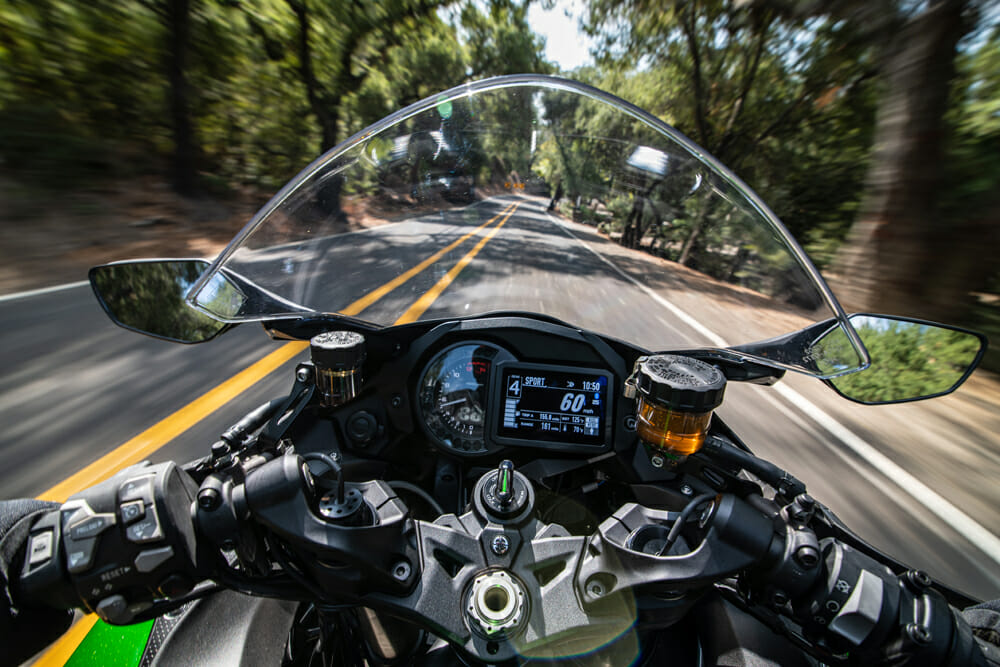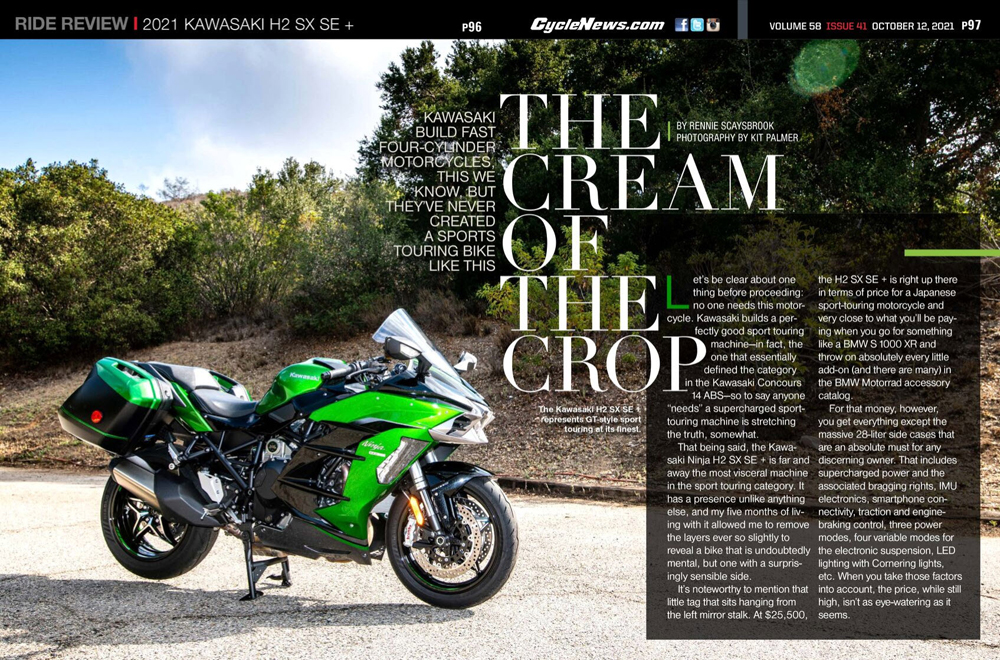Rennie Scaysbrook | October 18, 2021
Kawasaki builds fast four-cylinder motorcycles, this we know, but they’ve never created a sport-touring bike like this.
 The Kawasaki H2 SX SE + represents GT-style sport touring at its finest.
The Kawasaki H2 SX SE + represents GT-style sport touring at its finest.
Photography by Kit Palmer
Let’s be clear about one thing before proceeding: no one needs this motorcycle. Kawasaki builds a perfectly good sport-touring machine—in fact, the one that essentially defined the category in the Kawasaki Concours 14 ABS—so to say anyone “needs” a supercharged sport-touring machine is stretching the truth, somewhat.
That being said, the Kawasaki Ninja H2 SX SE + is far and away the most visceral machine in the sport-touring category. It has a presence unlike anything else, and my five months of living with it allowed me to remove the layers ever so slightly to reveal a bike that is undoubtedly mental, but one with a surprisingly sensible side.
 At nearly 600 pounds of claimed weight, it’s surprising how nimble the machine is.
At nearly 600 pounds of claimed weight, it’s surprising how nimble the machine is.
It’s noteworthy to mention that little tag that sits hanging from the left mirror stalk. At $25,500, the H2 SX SE + is right up there in terms of price for a Japanese sport-touring motorcycle and very close to what you’ll be paying when you go for something like a BMW S 1000 XR and throw on absolutely every little add-on (and there are many) in the BMW Motorrad accessory catalog.
For that money, however, you get everything except the massive 28-liter side cases that are an absolute must for any discerning owner. That includes supercharged power and the associated bragging rights, IMU electronics, smartphone connectivity, traction and engine-braking control, three power modes, four variable modes for the electronic suspension, LED lighting with Cornering lights, etc. When you take those factors into account, the price, while still high, isn’t as eye-watering as it seems.
 The side cases passed the helmet test with flying colors.
The side cases passed the helmet test with flying colors.
I’ve ridden each one of the supercharged H2 machines (bar the halo H2R track bike) over the years and they all have their own personality. Earlier this year, I spent a month with the naked Z H2 SE, a bike that had me fearing for my license each time I thumbed the starter motor. The Z was unruly, brash, frightening and seriously fun, but it was also not overly comfortable and pretty useless as anything other than something you scare yourself on each weekend.
The SX SE + is a different animal. For starters, it’s nearly 60 pounds heavier thanks to the vast swathes of metallic green bodywork, and there’s a feeling of distinction with this bike. Yes, it’s fast and yes, it has that gloriously scary supercharger rattle, but compared to the Z, it doesn’t feel as fast. I feel part of this is down to the weight, also partly down to the riding position where the raised clip-on handlebar and tall windscreen ensure you’re not completely exposed to the elements and thus the feeling of velocity is actually less.
 Your peripherals liquefy pretty quick on an H2.
Your peripherals liquefy pretty quick on an H2.
The ride position is about as sporty as Kawasaki can make it while still keeping their sportbike ego intact. From the company that brought you bikes like the ZX-10RR, the H2 SX SE +’s raised clip-ons, rubber-lined footpegs and super-wide rider and passenger seat give it a couchy feel for long-distance touring, one you can make as soft or as hard as you like when you delve into the electronic suspension modes for the Kawasaki Electronic Control Suspension (KECS).
As most of my riding during my tenure was done solo, I used the Sport setting for the majority of the rides, although you can delve into the Rider mode and make manual setting adjustments yourself in case you feel the programmed settings are not up to your standard. This will be especially useful if you’re riding two-up with full luggage, as the base settings might max out by the time you load everything up.
 Absolutely one of the prettiest rear wheels you can buy right now.
Absolutely one of the prettiest rear wheels you can buy right now.
I rode in the medium power level for the best part of a month, happy to leave a little in terms of absolute power on the table. However, stick the H2 motor into the full power mode and the SE + really comes alive. Although the power units are identical between the Z H2 SE and the SX SE +, the SX SE +’s application of propulsion when in the highest setting is not as abrupt as the Z’s. Drive seems to come in smoother and the chassis seems more planted, despite the Z also coming with the Kawasaki/Showa electronic suspension. As you can imagine, I didn’t venture back in the medium power mode after that first month.
There’s such a spread of torque on offer with this supercharger that it makes nearly every imaginable form of riding easy. A simple cruise to the shops where the revs never leave 3000 rpm is just as pleasurable as hitting up Palomar Mountain near San Diego and winding the green meanie out. Kawasaki has clearly fixed the Gatling gun-like throttle response issues that plagued the first generation of supercharged motors from the mid 2010’s. Traffic riding is a breeze and gives the SX an air of usability that belies its GT-style appearance.
 Rider and passenger comforts are well accommodated with the H2. The side grab handles offer plenty of real estate for your passenger.
Rider and passenger comforts are well accommodated with the H2. The side grab handles offer plenty of real estate for your passenger.
The clutch is surplus to needs once up and rolling, all gearshifts taken care of by the up-and-down quickshifter fitted as standard. The quickshifter can be a little jerky at low revs but once past about 25 mph, you’ll soon forget about the clutch and just go with the quickshift flow.
One of my favorite times to ride is at night, and I covered nearly 50 percent of my time on the Kawasaki when the sun went down. The vision offered by the LED headlights and cornering lights is excellent—bank the Kawasaki just past vertical and your inside line will light up faster than you can blink, illuminating the road ahead.
 Cornering lights were brilliantly at night and contribute to the svelte look of the H2.
Cornering lights were brilliantly at night and contribute to the svelte look of the H2.
Riding at night served to highlight an area where I had constant problems, and that was using my phone with the dash. Trying to use navigation and have my phone pair correctly was a constant problem, one that I eventually just gave up on and went old school by unpairing my phone to my headset and listening to the directions. A bike like this needs to have turn-by-turn navigation available on the dash, and its absence became a source of constant frustration as Google Maps sent me on all courses in the back streets of Downtown LA.
However, that was one of the only major gripes I had with the SX. As I mentioned, you’d be mad if you bought this and didn’t pick up the 28-liter side cases as these really complete the machine. They can easily hold a full-face helmet and a sweater in each case and use the ignition key, thus meaning you won’t have two keys on your key ring, the spare of which almost always scratches the ignition barrel.
 The ride position is a near perfect match of sports aggression and touring comfort.
The ride position is a near perfect match of sports aggression and touring comfort.
Long rides really are this machine’s wheelhouse, and I was surprised how long I could ride a motorcycle with clip-on handlebars and not get tired. The mixture of the bar position, seat and the screen angle were nearly spot on, however I’d like the screen to be a touch more vertical to direct wind higher over my Arai.
I wonder how many more machines Kawasaki will produce with this supercharged platform, and I sincerely hope this is the last one. Four is plenty as any more might dilute the aura of the rattling supercharger.
The Kawasaki H2 SX SE + is one of those luxury purchases you’ll probably only buy a few times in your life. It’s target audience of riders who ran the sportbike craze of 20 years ago may be dwindling, but it doesn’t disguise the fact this is an absolute tour de force from the Japanese company.CN

2021 Kawasaki H2 SX SE+ Specifications
| MSRP: |
$25,500 |
| Engine: |
Inline, four-cylinder, supercharged, 4-stroke |
| Cooling System: |
Liquid |
| Fueling: |
EFI |
| Displacement: |
998cc |
| Compression Ratio: |
11.2:1 |
| Bore x Stroke: |
76 x 55mm |
| Torque (claimed): |
86 lb-ft at 11,500 rpm |
| Transmission: |
6-speed |
| Clutch: |
Wet multi-disc |
| Chassis: |
Steel trellis |
| Front Suspension: |
43mm inverted fork with KECS-controlled rebound and compression damping, manual spring preload adjustability and top-out springs |
| Rear Suspension: |
Uni-Trak, Showa BFRC Lite gas-charged shock with piggyback reservoir, KECS-controlled compression and rebound damping, electronically adjustable spring preload |
| Front-Wheel Travel: |
4.7 in. |
| Rear-Wheel Travel: |
5.5 in. |
| Front Brake: |
Dual radial-mount, opposed 4-piston Brembo Stylema calipers, dual semi-floating 320mm discs; KIBS ABS |
| Rear Brake: |
Opposed 2-piston calipers, single 250mm disc, KIBS ABS |
| Front Tire: |
120/70 ZR17 in. |
| Rear Tire: |
190/55 ZR17 in. |
| Seat Height: |
32.9 in. |
| Wheelbase: |
58.3 in. |
| Rake: |
24.7° |
| Trail: |
4.1 in. |
| Fuel Capacity: |
5.0 gal. |
| Weight (curb, claimed): |
577 lbs. |
